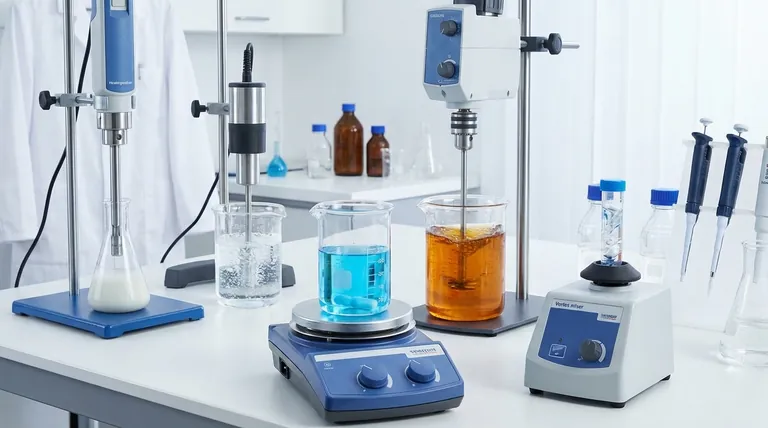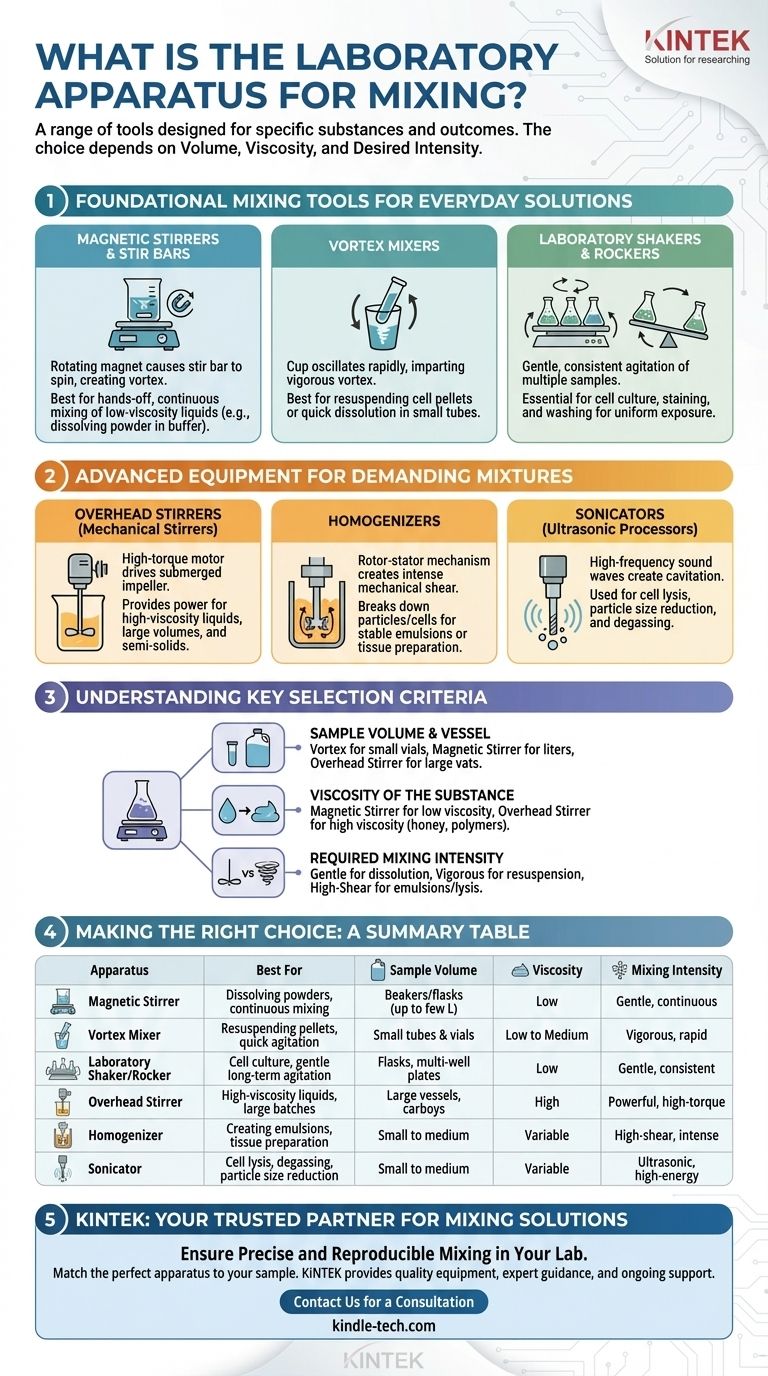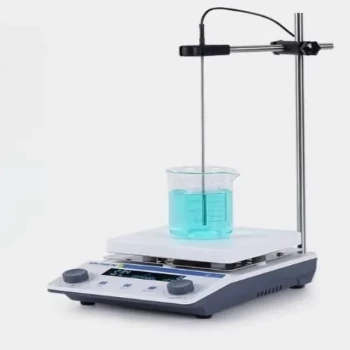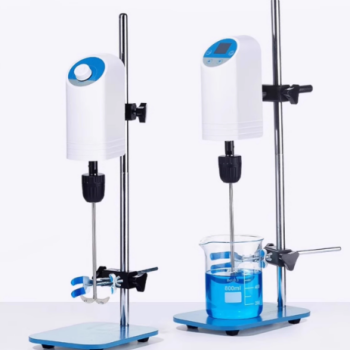The primary laboratory apparatus for mixing is not one single device, but a range of tools designed for specific substances and outcomes. The most common instruments are magnetic stirrers for continuous, low-viscosity mixing and vortex mixers for rapidly agitating small samples in tubes. More demanding tasks require specialized equipment like overhead stirrers, homogenizers, or sonicators.
The choice of mixing apparatus is determined by three critical factors: the volume of your sample, its viscosity (thickness), and the desired intensity of the mixing action, from gentle agitation to high-shear homogenization.

Foundational Mixing Tools for Everyday Solutions
These are the workhorse instruments found in nearly every biological and chemical laboratory. They handle the majority of routine mixing tasks for liquids and solutions.
Magnetic Stirrers and Stir Bars
A magnetic stirrer consists of a flat plate containing a rotating magnet. A separate, coated magnet called a stir bar is placed inside the liquid-filled vessel (like a beaker or flask).
When the plate is activated, the rotating magnet underneath causes the stir bar within the liquid to spin, creating a vortex that mixes the solution. This method is ideal for hands-off, continuous mixing of low-viscosity liquids, such as dissolving a solid powder into a buffer.
Vortex Mixers
A vortex mixer is a simple device with a small rubber cup that oscillates in a rapid, circular motion.
By pressing the bottom of a test tube or other small vial into the cup, the mixer imparts a vigorous vortex to the liquid inside. This is the standard method for resuspending cell pellets or quickly dissolving small amounts of a substance in a tube.
Laboratory Shakers and Rockers
Unlike stirrers or vortexers, shakers and rockers are designed for gentle, consistent agitation of multiple samples simultaneously.
They use a platform that moves in an orbital (shaker) or see-saw (rocker) motion. This is essential for applications like cell culture, staining gels, or washing blots, where samples require long periods of continuous, low-intensity movement to ensure uniform exposure to reagents.
Advanced Equipment for Demanding Mixtures
When working with viscous, large-volume, or complex samples, foundational tools are insufficient. Advanced equipment is required to deliver the necessary power and mechanical force.
Overhead Stirrers
An overhead stirrer, also known as a mechanical stirrer, is essentially a high-torque motor mounted above the sample vessel. It drives an impeller or paddle submerged in the substance.
This apparatus provides the power necessary to mix high-viscosity liquids, large volumes, or semi-solid materials like creams and polymers where a small magnetic stir bar would be ineffective.
Homogenizers
A homogenizer is designed to produce a uniform and consistent mixture, often by breaking down particles or disrupting tissues.
The most common type uses a high-speed rotor-stator mechanism. The rotor spins at thousands of RPM inside a stationary stator, creating intense mechanical shear that breaks down droplets, particles, or cells. This is essential for creating stable emulsions or preparing tissue samples for analysis.
Sonicators
A sonicator (or ultrasonic processor) uses high-frequency sound waves to agitate particles in a liquid.
A probe is submerged in the sample, where it emits powerful ultrasonic waves. These waves create and collapse microscopic cavitation bubbles, releasing immense, localized energy. This force is used for cell lysis (breaking open cells), reducing particle size, and degassing liquids.
Understanding the Key Selection Criteria
Choosing the wrong tool can lead to incomplete mixing, sample damage, or failed experiments. The decision should always be based on the physical properties of your sample and your ultimate goal.
Sample Volume and Vessel
The size of your sample is the first consideration. A vortex mixer is only suitable for small vials and tubes. A magnetic stirrer works well for beakers and flasks up to a few liters. For larger vats or carboys, an overhead stirrer is required.
Viscosity of the Substance
Viscosity, or a fluid's resistance to flow, is a critical factor. Magnetic stirrers are only effective for low-viscosity liquids like water or buffers. For anything thicker, like honey, glycerol, or polymer solutions, the torque from an overhead stirrer is necessary to maintain motion.
Required Mixing Intensity
The goal of your mixing dictates the intensity needed. Simple dissolution only requires the gentle agitation of a magnetic stirrer. Resuspending a pellet needs the vigorous action of a vortex mixer. Creating a stable emulsion or breaking open tough tissue requires the intense high-shear forces of a homogenizer or sonicator.
Making the Right Choice for Your Task
Use these guidelines to select the appropriate tool for your specific application.
- If your primary focus is dissolving a soluble powder into a buffer: A magnetic stirrer is your most reliable and efficient tool.
- If your primary focus is quickly resuspending a cell pellet in a centrifuge tube: A vortex mixer provides the necessary speed and force for this common task.
- If your primary focus is mixing a thick, viscous liquid or a large-volume batch: An overhead stirrer is required to deliver sufficient torque.
- If your primary focus is breaking open cells or creating a fine, stable emulsion: A homogenizer or sonicator is necessary to generate the required high-shear forces.
Selecting the correct mixing apparatus is a fundamental step that ensures the reproducibility, efficiency, and ultimate success of your laboratory work.
Summary Table:
| Apparatus | Best For | Sample Volume | Viscosity | Mixing Intensity |
|---|---|---|---|---|
| Magnetic Stirrer | Dissolving powders, continuous mixing | Beakers/flasks (up to a few liters) | Low (e.g., water, buffers) | Gentle, continuous |
| Vortex Mixer | Resuspending pellets, quick agitation | Small tubes and vials | Low to Medium | Vigorous, rapid |
| Laboratory Shaker/Rocker | Cell culture, gentle long-term agitation | Flasks, multi-well plates | Low | Gentle, consistent |
| Overhead Stirrer | High-viscosity liquids, large batches | Large vessels, carboys | High (e.g., polymers, creams) | Powerful, high-torque |
| Homogenizer | Creating emulsions, tissue preparation | Small to medium volumes | Variable | High-shear, intense |
| Sonicator | Cell lysis, degassing, particle size reduction | Small to medium volumes | Variable | Ultrasonic, high-energy |
Ensure Precise and Reproducible Mixing in Your Lab
Choosing the right mixing apparatus is critical for experimental success. The wrong tool can lead to incomplete results, sample damage, and wasted time.
KINTEK is your trusted partner for all laboratory mixing needs. We specialize in providing high-quality lab equipment and consumables, ensuring you have the precise tools required for your specific applications—from gentle agitation to high-shear homogenization.
Let our experts help you select the ideal mixer for your workflow. We provide:
- Expert Guidance: Match the perfect apparatus to your sample volume, viscosity, and intensity requirements.
- Quality Equipment: Reliable magnetic stirrers, vortex mixers, overhead stirrers, homogenizers, and more from leading brands.
- Ongoing Support: Ensure your equipment continues to perform for reproducible results.
Ready to optimize your mixing processes? Contact our team today for a personalized consultation and discover how KINTEK can enhance the efficiency and reliability of your laboratory work.
Visual Guide

Related Products
- Laboratory Small Constant Temperature Heated Magnetic Stirrer Heater and Stirrer
- High Performance Laboratory Stirrers for Diverse Applications
- Custom PTFE Teflon Parts Manufacturer for Magnetic Stirring Bar
- Three-dimensional electromagnetic sieving instrument
- Laboratory Disc Rotary Mixer for Efficient Sample Mixing and Homogenization
People Also Ask
- What is the function of a constant temperature heating and stirring device? Precision Control in Cr2O3 Nanoparticle Synthesis
- What is the purpose of continuous magnetic stirrer operation in photocatalytic Cr(VI) reduction? Optimize Efficiency
- What is the function of a magnetic stirring hot plate in zirconia-alumina synthesis? Master Solution Combustion Prep
- What roles do a magnetic stirrer and nitrogen protection play in Fe3O4 synthesis? Master Purity and Particle Size
- What role does a high-precision hot plate play in N-CXG synthesis? Achieve Perfect Precursor Homogenization



















